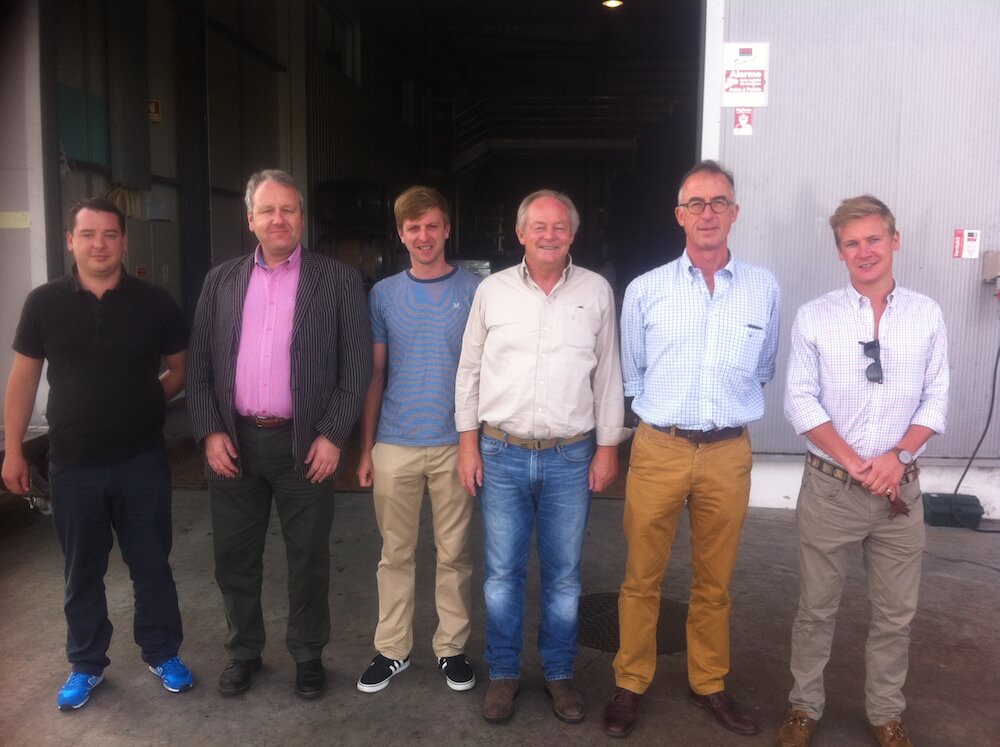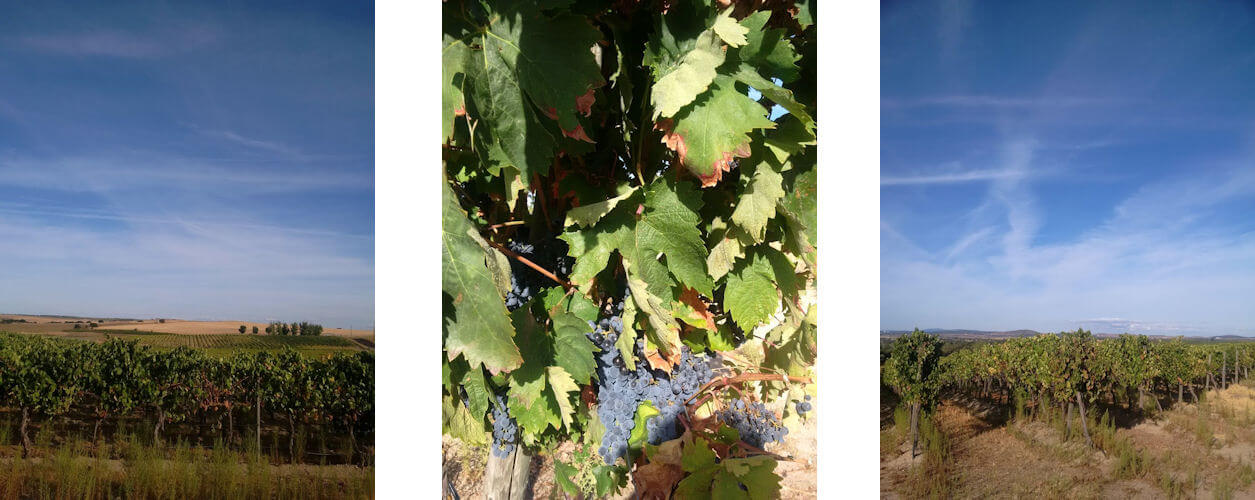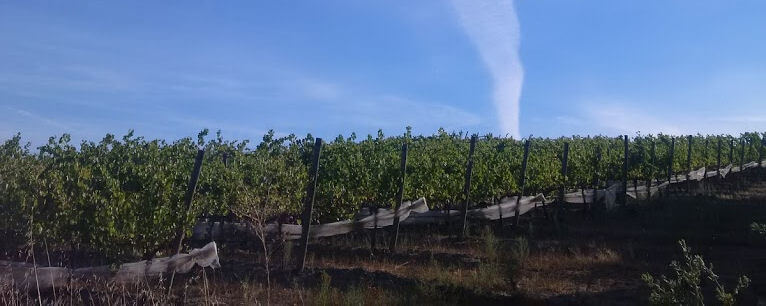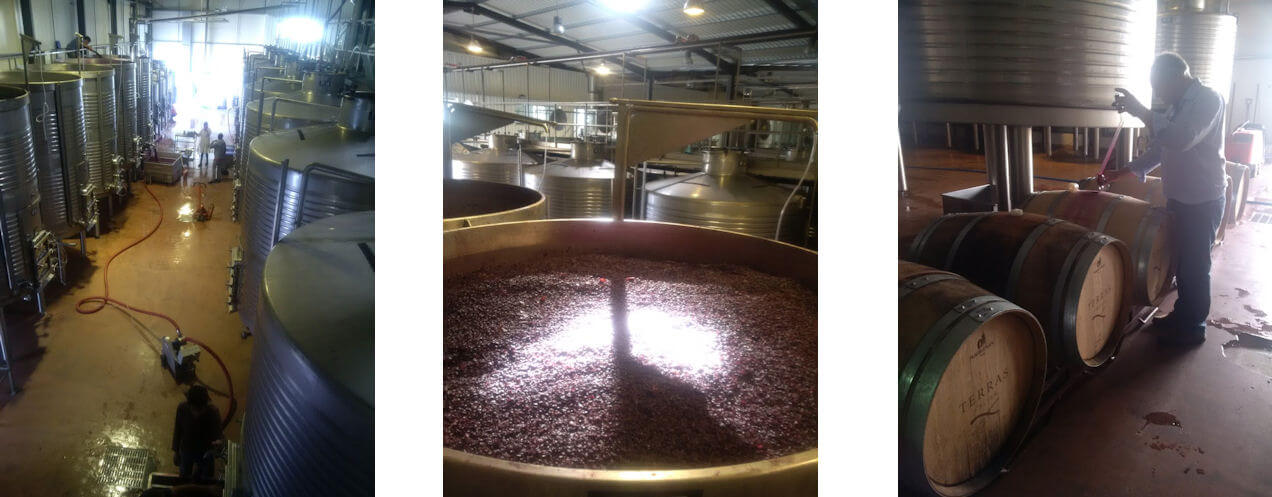Late September is a good time to head to Portugal for a couple of days – you get some welcome sunshine before the Christmas run in begins and, as the harvest is coming in, there’s plenty to see. Having sold more Terra d’Alter than our colleagues in the LEA & SANDEMAN estate, it was the Chiswick boys called to Heathrow early one Sunday morning to catch a Lisbon bound plane. From the airport it’s a good two hour plus drive inland, so afternoon was slowly giving way to evening when we arrived at Fronteira in the heart of the Alter Alentejo.
The Alentejo is a gently beautiful region of low hills and wide expanses of plain, such that it seems you can see for ever from the mildest of elevations. There are veritable forests of olive, the odd lonely shabby eucalyptus tree, vineyards both kempt and unkempt, the sun-baked straw of long dried out vegetation (it’s been a very hot Summer) and clusters of sheep and cows chewing at the what’s left of the grass. The roads are empty and so, mostly, are the sleepy towns and villages – you’d think that everyone is away working in the fields, except that the fields are empty too; there is only the occasional leather-skinned old man in a flat cap by way of human presence. There are plenty of churches and road-side shrines and buildings are of authentically solid construction, mostly white but decorated with vivid blue or yellow. If you tried to imagine what rural Portugal looks like, this is probably what you would imagine. And in the midst of this Iberian idyl is the forthright charming and very Australian winemaker Peter Bright and his sleek modern but compact winery.

The Lea & Sandeman team with winemaker, Peter Bright
Peter Bright came to Portugal, initially, in the mid-1970’s for “surf, and other stuff” and settled permanently there in 1982. Even whilst studying viticulture at Roseworthy (Adelaide’s agricultural college), his dissertation was on Portuguese grape varieties, a topic that he has an encyclopedic knowledge of, and passion for, to this day. And Portugal seems to have a lot of grape varieties, many not found outside Portugal. Apparently, there are only about twenty but they all have different names in different regions giving rise the myriad of names encountered across the country. Mind you, twenty is enough, isn’t it?
One grape variety not, originally, indigenous to Portugal is Arragonez. As the name may suggest, Arragonez was originally Spanish and is none other than Tempranillo. After the devastation of phylloxera, when so many vineyards were destroyed and had to be replanted, many were replanted with Arragonez. It has thrived in regions like the Alentejo, but mostly because of its ability to crop well, often at the expense of quality. Peter is working to control Arragonez yields and find the innate quality of this great Iberian variety, and this shows in the deep ripe intense wines he makes from it. Interestingly, and gratifyingly, the wines are very different to Spanish Tempranillo. It is Arragonez that is used to make Terra d’Alter’s zero-SO₂ red wine – a concept which feels so faddishly a la mode but which, according to Peter, harks back to the days before modern technology found its way to the region.
Another variety introduced in the wake of phylloxera and favoured for its bounteous cropping was Alicante Bouschet. A 19th Century French crossing and one of the very few red-fleshed grape varieties, Alicante Bouschet is emerging as one of the ideal grape varieties in the Alentejo, especially when in the hands of a master like Peter Bright. The simple varietal Alicante Bouschet is a deep brambly delight but Peter had us in raptures when he let us taste his newest premium wine – Sete Linhas – from seven rows of outstanding Alicante Bouschet. Sexy velvet smooth currant fruit, ripe and juicy but so wonderfully balanced; delicious now, but well worth ageing. It was so new, the labels haven’t even been printed yet, but it’s one we’ll shout about if we get any – seven rows of vines with restricted yields doesn’t leave a lot of wine to go around.
If Peter has a pet red variety, you get the impression it’s Alfrocheiro – “the Pinot of Portugal” he is want to say, drawing on some obscure genealogical relationship to give his point technical as well as stylistic validity . It’s certainly a softer, more seductive red than most you will find in Portugal and may be our best selling red from Terra d’Alter.
The grape varieties come thick and fast – if somebody grows it, Peter Bright is keen to try vinting it. We tried Tinta Cão, and Touriga Nacional, we tried three vintages of the big luxurious Outeiro (a 50/50 Syrah/Petit Verdot blend), we tried Moreto, we tried Tinta Caiada. We even tried some barrel-fermented Cabernet Sauvignon destined to play a small part in the Terra d’Alter Reserve Red.
There is a Reserve White too, a wine which would not look out of sorts in the company of good Californian Chardonnays, not that there’s any Chardonnay to be found at Terra d’Alter, the Reserve being a slightly variable blend of mostly Arinto and Siria. We were treated to a vertical flight of the Terra d’Alter Reserve White (2014, 2012 and the awesome 2009) over dinner to illustrate how well these wines age and, boy, do they age well. Not that anyone ages £14 Portuguese whites…maybe they should start.
Among the white varieties of the Alentejo, Peter is keen to shout of the virtues of Siria, Arinto and Verdelho – all delightful, from the gentle peachiness of Siria to the drier more crunchy Verdelho. Some way south of its natural territory is Alvarinho, better known to the world as the Spanish Albariño. The Terra d’Alter Alvarinho is more focussed and linear than its northern incarnation with precise crisp fruit – it’s a lovely aperitif.
But Peter’s white baby really is Viognier, a variety he introduced to the region (others have since followed suit). Somehow, Peter manages to retain acidity in this infamously low-acid variety and his Viognier is a charm – aromatic, of course, but refreshing too; you wouldn’t guess it had come from such a warm southerly location. Terra d’Alter also produce small quantities of a Late Harvest Viognier, something we were shown as a fermenting 2016 must (which tasted of puréed mango), a 2015 barrel sample (which had travelled a long way in a year) and after dinner with the bottled 2012. We got to know it quite well.
There is, even, a dry pale rosé in the Terra d’Alter range and the rogue bottle of MiP* Rosé in the corner of the tasting room showed from whence inspiration was drawn. The many empty Condrieu bottles in the tasting room also spoke of inspiration, this time of course for Peter’s Viognier.
We were lucky enough to see some of the Terra d’Alter vineyards. At our feet, among the grey white soil were flecks of brick red – fragments of Roman roof tiles. At the edge of the vineyard was an ancient burial ground, in use from Roman times to the Medieval era, now overgrown with scrub. As the sun started to drop behind the field of Viognier on one side of the road, on the other we walked among Arragonez that still awaited picking whilst Peter gave us his own take on the concept of terroir. In the distance were rows of Sira and Alvarinho. Beyond that the Alter Alentejo stretched out for miles.
In the winery, even late on a Sunday, men were at work pumping over open topped fermenters of Syrah/Viognier, Alfrocheiro and Arragonez. From the gantry we could look down into the fermenting musts – the reds sedate, nearing the end of their fermentation; a tank of fermenting Verdelho was much more lively with aromatic froth dancing atop the tank. We were treated to a quick taste of some of the fermenting 2016 wines – some clearly tasted of the finished product, some had a long way to go – fascinating, instructive and occasionally baffling.
A night in a hotel fashioned from an old convent at Alter de Chão and, all too soon, it was time to head back to the airport at Lisbon taking with us a better understanding of the Alentejo and renewed enthusiasm for Terra d’Alter. The wines are instantly attractive, well-flavoured, well-balanced and truly great value. The whites have charm and crisp refreshment, with deep levels of complexity shown by some of the premium wines. The reds are assertive, deeply fruited, brilliant food wines with anything from simple suppers up to Sunday roast and more than ideal with the BBQ, and rise to quite sublime levels at the grander end. And most of them, or all of them if Peter Bright is to be believed, have some ability to age – try saying that of a £10 bottle of Bordeaux.
Portugal is still relatively under-discovered by the oenophile; dusty old bottles of Dão, fizzy sweet pink wines and the occasional Vinho Verde form the bulk of most people’s experiences. But there is so much more to Portugal than that. Maybe it’s time to reacquaint yourself with Portuguese wine, and there’s no better place to start than the Alentejo and the fabulous wines of Terra d’Alter.


